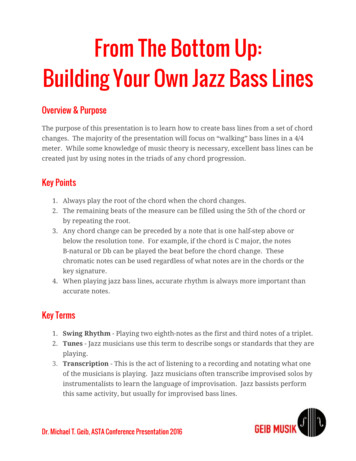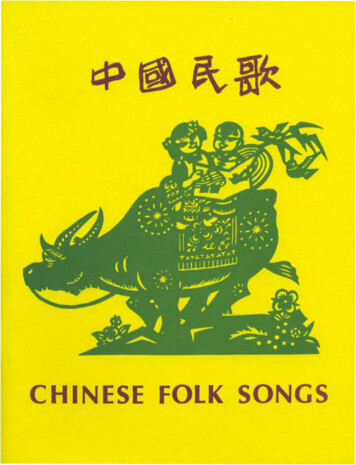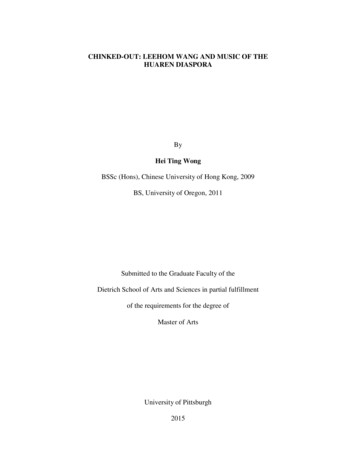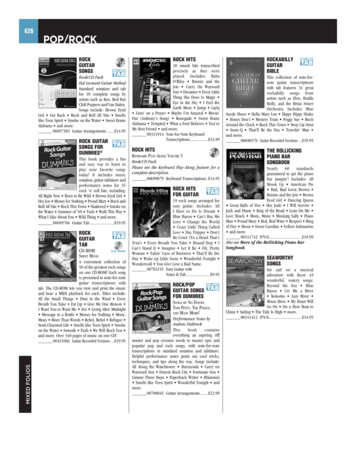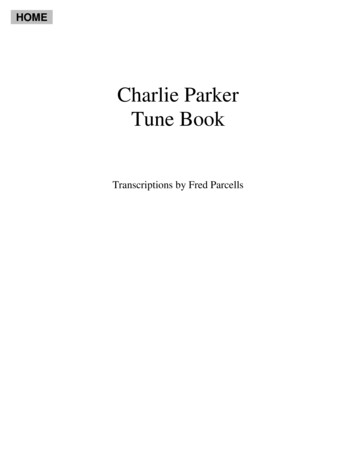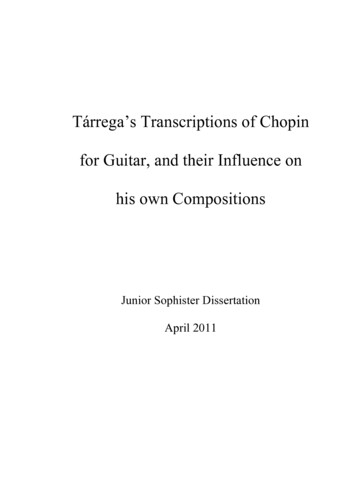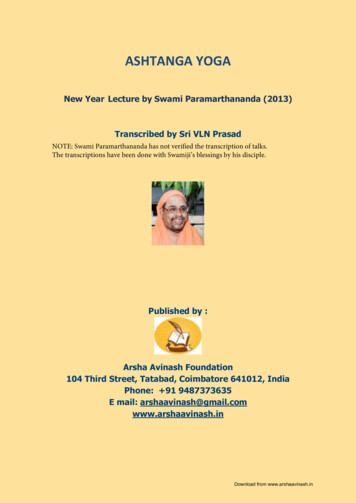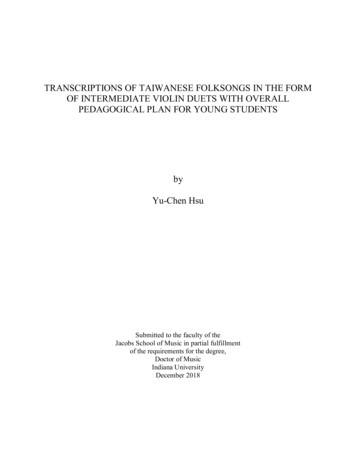
Transcription
TRANSCRIPTIONS OF TAIWANESE FOLKSONGS IN THE FORMOF INTERMEDIATE VIOLIN DUETS WITH OVERALLPEDAGOGICAL PLAN FOR YOUNG STUDENTSbyYu-Chen HsuSubmitted to the faculty of theJacobs School of Music in partial fulfillmentof the requirements for the degree,Doctor of MusicIndiana UniversityDecember 2018
Accepted by the faculty of theIndiana University Jacobs School of Music,in partial fulfillment of the requirements for the degreeDoctor of MusicDoctoral CommitteeMark Kaplan, Chair and Research DirectorBrenda BrennerJorja FleezanisMimi ZweigOctober 9, 2018ii
Copyright 2018Yu-Chen Hsuiii
AcknowledgementsI would like to express my deepest appreciation to my committee chair, Prof. MarkKaplan, for guiding me with his extraordinary musicianship and knowledge, and for encouragingand challenging me to be a better musician; to Prof. Mimi Zweig, for walking me through thejungle of violin pedagogy and sharing her incredible perspectives and insights; to Prof. BrendaBrenner, for showing me how to design effective and efficient pedagogical plans, and giving methe opportunity to work with the violin students at Fairview Elementary School.I would like to thank Prof. Chien-Jer Charles Lin for helping me with the Englishtranslations of the Taiwanese folksong lyrics; the Indiana University String Academy program,for letting me learn valuable violin methods and work with wonderful teachers, as well as all myteachers, colleagues, and friends who helped me broaden my horizons and be a better humanbeing. In an altogether different spirit, I would also like to thank my sweet cat, Milky, for beingmy stress reliever and enduring my excessive harassment.Last, I am extremely grateful to my dearest parents and sister, for their unconditionalsupport, love, and care. Without them, I would not be who I am today. I am fortunate indeed tohave them as my family!iv
Table of ContentsAcknowledgements . ivTable of Contents .vList of Appendices . viIntroduction .11. The Snail and the Oriole Birds .42. The Springtime Hill .103. An Old Train Song .154. Moonlight Sorrow .195. Miss Peach Blossom Takes the Boat .256. A Cloudy Day .317. The Dusk at Tamsui .378. If We Open Our Mind .449. The Summer Rain Keeps Falling Down .5010. Yearning for the Spring Breeze .5611. Loving You in Four Seasons .6412. The Rainy Night Flower .73Bibliography.89v
List of AppendicesAppendix A: Flat–Natural–Sharp Three-Position Exercises .80Appendix B: Half-Step Scale Exercises. .81Appendix C: Natural Harmonics on Violin. .83Appendix D: Original Chinese Song Lyrics .84vi
IntroductionThis educational violin-duet book is designed to enable intermediate level violinists toexplore the beauty of Asian folk music while mastering various essential technical and ensembleskills. With this goal in mind, the author has created two-violin transcriptions of twelve selectedTaiwanese folksongs. Although the parts are identified as Violins I and II, these duets aredesigned to be performed by two students of equal facility. This repertoire will enable students togain collaborative experience with duet playing at an earlier stage than is commonly the case,and will stimulate their sensitivity to intonation and rhythm.In these transcriptions, the first violin and second violin parts often alternate the melodyand harmony symmetrically, enabling them to participate in both leading and accompanyingroles. Furthermore, the students are learning to hear the same tune from different perspectiveswhile simultaneously working to balance and blend their sound as an ensemble. The duets areharmonically self-contained, eliminating the need for an accompanying piano part.A variety of compositional methods and violin techniques are combined to enrichstudents’ learning experience. The use of natural harmonics, broken chords, and glissandifacilitates students’ intonation control and hand-frame building. A mixture of left-hand pizzicato,right-hand pizzicato, and bowed passages promotes aspects of physical coordination commonlyused in violin playing. Moreover, students explore a variety of textures and tonal landscapes withthese duets, such as pentatonic modes, bitonality, and ostinato accompaniment.With the goal of training students to keep a steady pulse and play together, the rhythmicsettings include examples with one part playing a rhythmic drone or subdivided pattern, as wellas both parts playing the same rhythms. The rhythmic roles are balanced between the two parts,requiring both players to listen attentively to each other and to interact accordingly.1
The author has integrated images and characters from the folk songs in thesetranscriptions to stimulate the student’s creativity and imagination. For example, the technique ofonomatopoeia is employed here by calling upon a wide range of violin sounds and articulationsto evoke train whistles, raindrops, thunder, etc.The music is arranged in keys that allow the players to tune frequently to open strings,thereby helping them to develop their relative pitch, and strengthening their ability to play withconsistent intonation. The pitch range fits predominantly into first and third positions with theoccasional use of second position and some natural harmonics reaching into higher positions.The songs are selected based on melody, rhythm, style, and lyrics. All of these folksongsare originally sung in Taiwanese (also known as Hokkien, a branch of Southern Min Chinesedialect), with the exception of the song “The Snail and the Oriole Birds” which is sung inMandarin. These songs are familiar to millions of Taiwanese as well as the Hokkien-speakingpopulations of Southeast Asia. An introduction precedes each duet score, providing the historicalcontext and lyrics of each song as well as the author’s compositional ideas, pedagogicalhighlights, and violin practicing exercises.The difficulty level of the duets is generally progressive, in that they become graduallymore demanding during the course of the twelve songs. Depending on the students’ age anddevelopment level, to simply play the notes and rhythms at a moderate tempo will be anappropriate challenge for some, while to realize the dynamics, articulations, and characters at fulltempo can challenge more advanced students. A lot of the information and historical backgroundwill be of more interest to older students; in the case of younger students, the teacher may wantto decide which points would be especially worth mentioning for each student.2
For research and reference materials, the author has focused on the pedagogical studies ofthe Suzuki Violin Method, the Mimi Zweig String Pedagogy, and the Royal Conservatory ViolinSeries along with the supplemental materials used by the String Academy of the Jacobs Schoolof Music. The author also drew inspiration from a wide range of two-violin repertoire, butespecially from the duo works of Bartók and Ligeti.3
1. The Snail and the Oriole Birds (蝸牛與黃鸝鳥)Historical context:This playful song, published in 1979, is composed by Hong-Wen Chen (陳弘文) with lyrics byJian-Chang Lin (林建昌). In this song, the snail disregards the laughs of the oriole birds andcontinues climbing up the grapevine to eat the grapes. The story of the snail encourages peopleto pursue their goal even though the journey may be time-consuming and challenging. Also,when you think someone is behaving foolishly, don’t jump to conclusions – they may actuallyhave a good reason for their actions.Lyrics:In front of the door is a grapevine.Its green, tender shoots have just started to sprout.A snail carries his heavy shell, climbing up step by step.Two oriole birds sit on the grapevine.They laugh at the snail, saying,“It will be a long time before the grapes are ripe.Why are you climbing now?”Says the snail,“Don’t laugh at me, orioles.By the time I reach the grapes, they will be ripe.”Compositional ideas: Snail climbing with his heavy shell: double stops with tenuto (Vn. II mm. 5–8) Oriole birds’ laughing: accented tremolo (Vn. I mm. 9–14; Vn. II mm. 19–22) Snail speaking slowly: the theme in augmentation (Vn. I mm. 19–28) Climbing motion: upward glissando (Vn. II mm. 25–26) Snail eating ripened grapes: two pizzicato quarter notes (Vn. II mm. 27–28)Pedagogical highlights:Left hand Natural harmonics Glissando PizzicatoRight hand Broken intervals with string crossing Double stops with open string Accented tremoloMusical terms Andante: (“walking, going, fluent” in Italian) playing in a moderately slow tempo. Leggiero: “light, delicate” in Italian. Tremolo: (“trembling, shaking, quavering” in Italian) rapidly repeating a single notewith very short bow strokes.4
Glissando: sliding from one note to another without a break (from glisser: “to slide” inFrench). Also known as portamento.Poco Rit. (abbreviation for Poco Ritardando or Poco Ritenuto): slightly slowing downin Italian (Poco: “little, slightly”; Ritardando: from ritardare “to delay”; Ritenuto: fromritenere “to detain, hold back”).5
Practicing ExercisesExercises for double stops (mm. 5–8)1. Upper Half2. Lower Half 4& 4 œ œ œ œ œ œ œ œ œ œ œ œ œœ œœ œ œ œ œ œœ œœ œ œ œ œœ œœ œ0 0 œ œ œ œ œ œœœœ œ œ œ œ œ œ œ œœ œœ œ œ œ œ œœ œœ & œ œ œ œ1 0 1 00 1 œ œ œ œ œ œ œ œ œ œ œ œ & #œ œ œ œ œœ œœ œ#œ œ œ œœ œœ œ œ œ œ2 0 2 01 0 1 0 & œœ œœ œœ œœœœ #œœ œœ œœœœ œœ œœ œœœœ œœ œœ œœ œœ #œœ œœ œœœœ œœ œœ œœœœ œœ œœ œœ Whole Bow0110 œœœœ& œ œ œ œ01102230304040Exercises for matching the 4th finger with open string (mm. 1, 9)Détaché1. Middle of the Bow2. At Frog3. At Tipœ œ& œ œ œ œ #œ œ0œ œ 0œ œ œ œ œ œ1œ œ œ œ #œ œ œ œ&40(leave 4th finger down)œ œ0644œ œ 0œ œ 4œ œ4
Exercises for glissando (m. 16)Shifts are slow. ‚ Whole Bow #œ #œ œ œœ& 0213 ‚303œ 30œ 0œ30O‚œ 30(shifting the hand whileplaying the open E)3Exercises for tremolo (mm. 9–12; 19–22)Using very short bow and engaging mainly wrist and finger (feeling like –almost dropping the bow; up-bow is the rebound of the down-bow)1. At the tip2. At the middle& & & & &œ œ œ œ œ œ 3œœ ‰ Œœœœœ‰ Œœ œ œ œ œ œ Œœœ ‰ Œœœœœœœœ œ œ œ œ œ œ œ œ œ œ œ œ œ œ œœœœœ‰ Œ ‰ Œœœœœ‰ Œœœœœœœ Œœœ ‰ Œ‰ Œœœœœœœ Œœ œ œ œ œ œ œ œŒœ œ œ œ œ œ œ œŒ & & 10œ #œ1223œ #œ22#œ œ 233030#œ ‚œ #2œ # O3‚ #œ 72#œ œ œ œ2233030#œ ‚‚ ŒŒ2 Œ Exercises for glissando (mm. 25–26)Shifts are slow.Whole Bow00 3œ
1. The Snail and the Oriole Birds(蝸 與 鸝 )( q 63 )arranged by Yu-Chen HsuAndanteViolin I4 ### 2 œ œ œ œ œ œ . œ. œ.œ œ œ œ œ œ . œ. œ. ‰‰œ Jœ J& 4mf leggieroViolin II ### 2& 4œœœ. . œ. .œ œœœœ. . œ. . œ. . œ. .œ œœ. . œ. .mp5 ### œ 4œ œ œ œ œ œœ œ. œ&.###œœ &-œœœ . œJ ææ9 ### ‰&œ-œ jœ œ œ œ œœ. œ. œ. ‰œ-œœ-œœ.‰ J œæ扜-œœ. œJ ææ-œœœ.‰ J-œœ œææmp 4### œ œ&œ œ œ œ . œ. œ. ‰œJœ œœ œ œ œ . œ. œ. ‰œJmf leggiero ### œ œ æœæ&13### œ &œ œ œææœ œ 4œœ œœ œ œœœ . œ. œ8œ œœ . -œ ‰ J30 œœ œœ œ. œ. jœ. ‰
17 ### -œ &(The snail speaking)-œjœ œf .œœ œ œ œ ‰ Jœ œ œ œ- ### &œ œ œ œjœ œœ œ œœ. œææ‰ J ææmp21 ###&œœœœœ### ‰ &œ. œJ ææœ. œJ æ扜œœœœ œœœ425 ###&Œ poco rit.gliss.2###œœ œœ& gliss. 330œ œ œ œpizz.Œmfpoco rit.9œ œ œŒ
2. The Springtime Hill (滿山春色)Historical context:The song, published in 1939, is composed by Chiu-Lin Chen (陳秋霖 1911-1992) with lyrics byDa-Ru Chen (陳達儒 1917-1992). The lyrics describe a young, loving couple visiting a beautifulhill in the spring. The melody is set in a D major pentatonic scale (D–E–F#–A–B).Lyrics:The hill is bursting with spring.What a beautiful place to
This educational violin-duet book is designed to enable intermediate level violinists to explore the beauty of Asian folk music while mastering various essential technical and ensemble skills. With this goal in mind, the author has created two-violin transcriptions of twelve selected Taiwanese folksongs. Although the parts are identified as Violins I and II, these duets are
